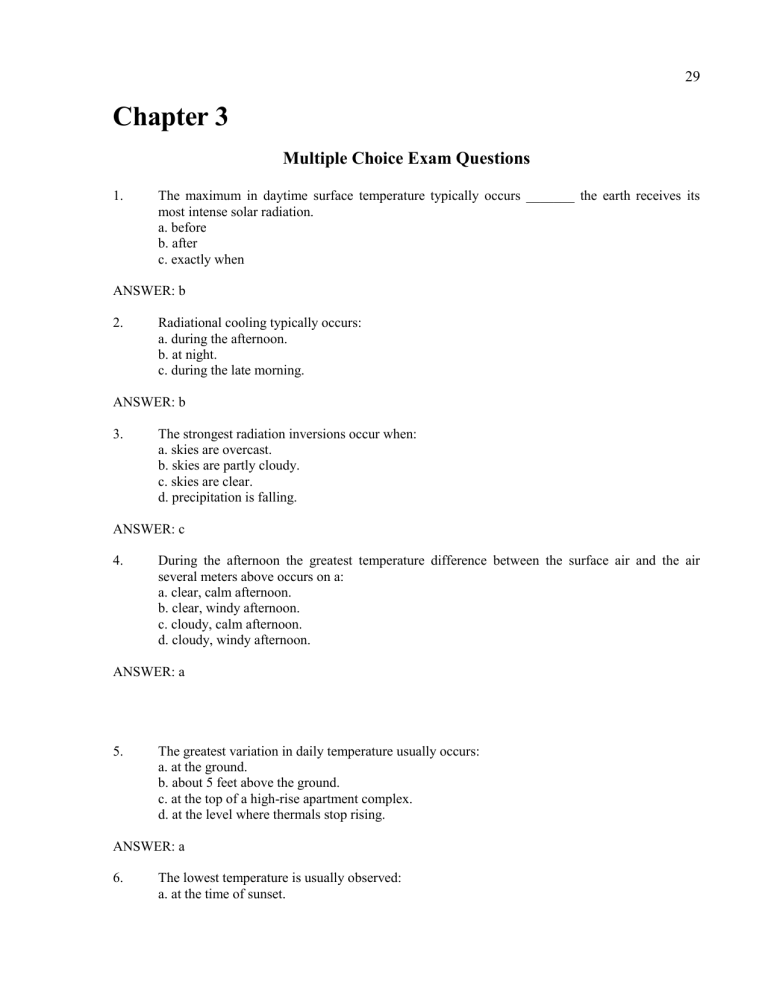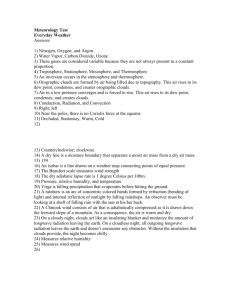Chapter 2 - Amazon S3

29
Chapter 3
Multiple Choice Exam Questions
1. The maximum in daytime surface temperature typically occurs _______ the earth receives its most intense solar radiation. a. before b. after c. exactly when
ANSWER: b
2. Radiational cooling typically occurs: a. during the afternoon. b. at night. c. during the late morning.
ANSWER: b
3. The strongest radiation inversions occur when: a. skies are overcast. b. skies are partly cloudy. c. skies are clear. d. precipitation is falling.
ANSWER: c
4. During the afternoon the greatest temperature difference between the surface air and the air several meters above occurs on a: a. clear, calm afternoon. b. clear, windy afternoon. c. cloudy, calm afternoon. d. cloudy, windy afternoon.
ANSWER: a
5. The greatest variation in daily temperature usually occurs: a. at the ground. b. about 5 feet above the ground. c. at the top of a high-rise apartment complex. d. at the level where thermals stop rising.
ANSWER: a
6. The lowest temperature is usually observed: a. at the time of sunset.
30 b. near midnight. c. several hours before sunrise. d. around sunrise. e. several hours after sunrise.
ANSWER: d
7. In clear weather the air next to the ground is usually __________ than the air above during the night, and __________ than the air above during the day. a. colder, warmer b. colder, colder c. warmer, colder d. warmer, warmer
ANSWER: a
8. Suppose yesterday morning you noticed ice crystals (frost) on the grass, yet the reported minimum temperature was only 35 o F. The most likely reason for this apparent discrepancy is
9. that: a. temperature readings are taken in instrument shelters more than 5 feet above the ground. b. the thermometer was in error. c. the newspaper reported the wrong temperature. d. the thermometer was read before the minimum temperature was reached for that day. e. the thermometer was read incorrectly.
ANSWER: a
At what time during a 24-hour day would a radiation temperature inversion best be developed? a. at sunset b. near sunrise c. toward the end of the morning d. between 2 and 5 pm when the air temperature reaches a maximum
ANSWER: b
10. The primary cause of a radiation inversion is: a. infrared radiation emitted by the earth's surface. b. infrared radiation absorbed by the earth's surface. c. solar radiation absorbed by the earth's surface. d. solar radiation reflected by the earth's surface. e. infrared radiation absorbed by the atmosphere and clouds.
ANSWER: a
11. In a hilly region the best place to plant crops that are sensitive to low temperatures is:
31 a. on the valley floor. b. along the hillsides. c. on the top of the highest hill. d. in any dry location.
ANSWER: b
12. An important reason for the large daily temperature range over deserts is: a. there is little water vapor in the air to absorb and re-radiate infrared radiation. b. the light-colored sand radiates heat very rapidly at night. c. dry air is a very poor heat conductor. d. free convection cells are unable to form above the hot desert ground. e. the ozone content of desert air is very low.
ANSWER: a
13. Which of the following statements is/are true? a. If you travel from Dallas, Texas to St. Paul, Minnesota in January, you are more likely to experience greater temperature variations than if you make the same trip in July. b. Annual temperature ranges tend to be much greater near the ocean than in the middle of the continent. c. If two cities have the same mean annual temperature, then their temperatures throughout the year are quite similar. d. all of the above are true
ANSWER: a
14. The largest annual ranges of temperatures are found: a. at polar latitudes over land. b. at polar latitudes over water. c. at middle latitudes near large bodies of wate.r d. at the Equator. e. in the Northern Central Plains of the United States.
ANSWER: a
15. Over the earth as a whole, one would expect to observe the smallest variation in temperature from day to day and from month to month: a. at the North Pole. b. in the center of a large land mass. c. along the Pacific coast of North America. d. high in the mountains in the middle of a continent. e. on a small island near the equator.
ANSWER: e
32
16. Referring to Table 3.3: The air temperature is 45 o F, the wind is blowing at 30 MPH, and the wind chill temperature is 15 o F. These conditions would be equivalent to: a. a 15 o F air temperature and 0 MPH winds. b. a 30 o F air temperature and 45 MPH winds. c. a 30 o F air temperature and 15 MPH winds. d. a 15 o F air temperature and 30 MPH winds.
ANSWER: a
17. The wind-chill factor: a. relates body heat loss with wind to an equivalent temperature with no wind. b. indicates the temperature at which water freezes on exposed skin. c. takes into account humidity and air temperature in expressing the current air temperature. d. tells farmers when to protect crops from a freeze. e. determines how low the air temperature will be on any given day.
ANSWER: a
18. Which of the following statements is not correct? a. Calm, cloudy nights are usually warmer than calm, clear nights. b. Each year the earth's surface radiates away more energy than it receives from the sun. c. The horizontal transport of heat by the wind is called advection. d. Good absorbers of radiation are usually poor emitters of radiation.
ANSWER: d
19. Suppose last night was clear and calm. Tonight low clouds will be present. From this you would conclude that tonight's minimum temperature will be:
33
7.
5.
4.
6.
3.
1.
2. a. higher than last night's minimum temperature. b. lower than last night's minimum temperature. c. the same as last night's minimum temperature. d. above freezing.
ANSWER: a
20. Low clouds retard surface cooling at night better than clear skies because: a. the clouds absorb and radiate infrared energy back to earth. b. the water droplets in the clouds reflect infrared energy back to earth. c. the clouds start convection currents between them. d. the clouds are better conductors of heat than is the clear night air. e. the formation of the clouds releases latent heat energy.
ANSWER: a
True/False Exam Questions
In meteorology, the term thermal belt refers to the extreme heat sometimes found inside a car.
ANSWER: false
In most areas the warmest time of the day close to the ground occurs in the afternoon between 2 and 5 pm.
ANSWER: true
Assuming that the night will remain clear, calm and unsaturated, the predicted minimum temperature is 32 o F. Suddenly the wind speed increases and remains gusty throughout the night.
The minimum temperature will most likely be higher than predicted due to the release of latent heat.
ANSWER: false
A clear, calm, dry winter night would be ideal conditions for a strong radiation inversion.
ANSWER: true
Lines on a weather map connecting points of equal temperature are called isotherms.
ANSWER: true
In summer, humid regions typically have smaller daily temperature ranges and lower maximum temperatures than drier regions.
ANSWER: true
Water warms and cools much more slowly than land because it takes more heat to raise the
34 temperature of a given amount of water 1 o C than it does to raise the temperature of soil 1 o C.
9.
8.
ANSWER: true
Hypothermia is most common in cold, dry weather.
ANSWER: false
An ideal shelter for housing a temperature-measurement instrument should be white and in the shade.
ANSWER: true
10. At any given time, one-fourth of the earth is illuminated by the sun.
ANSWER: false
Essay/Critical Thinking Exam Questions
1. If you lived in the Arizona desert, would you want to own a black car? Why or why not? What might be a better color?
2. An air temperature of 70 o F feels quite comfortable. If you were in 70 o F water, it would feel cold. Explain why.
3. Explain why it is possible for the nighttime minimum to occur as much as 30 minutes after the sun has risen.
4. What is the hottest (coldest) place in the United States? In the world? What factors cause these extreme conditions at these locations?
5. Explain why it is possible to see frost on the ground or on the tops of parked automobiles even though the measured nighttime minimum temperature remains above 32 o F.
6. How is it possible for the ground to become warmer than the air just above during the day and then turn colder than the air above during the night?
7. A city which is located near a large body of water will generally have a milder climate than a city located at the same latitude in the center of a large mass. What factors account for this?
8. Would a strong radiation inversion be more likely to form on a winter night or a summer night?
Explain your answer.
9. Why, specifically, are heat waves hazardous to your health?
10. Why don't wind chill temperature charts include temperatures above 40 o F?








